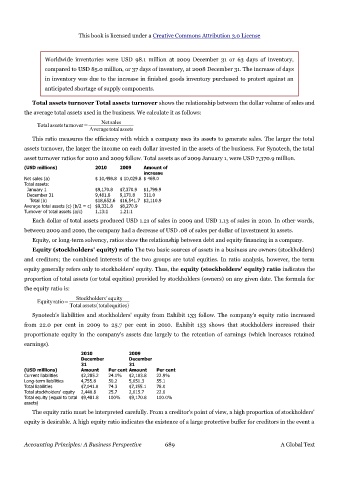Page 688 - Accounting Principles (A Business Perspective)
P. 688
This book is licensed under a Creative Commons Attribution 3.0 License
Worldwide inventories were USD 98.1 million at 2009 December 31 or 63 days of inventory,
compared to USD 85.0 million, or 37 days of inventory, at 2008 December 31. The increase of days
in inventory was due to the increase in finished goods inventory purchased to protect against an
anticipated shortage of supply components.
Total assets turnover Total assets turnover shows the relationship between the dollar volume of sales and
the average total assets used in the business. We calculate it as follows:
Netsales
Total assets turnover=
Average totalassets
This ratio measures the efficiency with which a company uses its assets to generate sales. The larger the total
assets turnover, the larger the income on each dollar invested in the assets of the business. For Synotech, the total
asset turnover ratios for 2010 and 2009 follow. Total assets as of 2009 January 1, were USD 7,370.9 million.
(USD millions) 2010 2009 Amount of
increase
Net sales (a) $ 10,498.8 $ 10,029.8 $ 469.0
Total assets:
January 1 $9,170.8 $7,370.9 $1,799.9
December 31 9,481.8 9,170.8 311.0
Total (b) $18,652.6 $16,541.7 $2,110.9
Average total assets (c) (b/2 = c) $9,331.8 $8,270.9
Turnover of total assets (a/c) 1.13:1 1.21:1
Each dollar of total assets produced USD 1.21 of sales in 2009 and USD 1.13 of sales in 2010. In other words,
between 2009 and 2010, the company had a decrease of USD .08 of sales per dollar of investment in assets.
Equity, or long-term solvency, ratios show the relationship between debt and equity financing in a company.
Equity (stockholders' equity) ratio The two basic sources of assets in a business are owners (stockholders)
and creditors; the combined interests of the two groups are total equities. In ratio analysis, however, the term
equity generally refers only to stockholders' equity. Thus, the equity (stockholders' equity) ratio indicates the
proportion of total assets (or total equities) provided by stockholders (owners) on any given date. The formula for
the equity ratio is:
Stockholders'equity
Equity ratio=
Totalassetstotalequities
Synotech's liabilities and stockholders' equity from Exhibit 133 follow. The company's equity ratio increased
from 22.0 per cent in 2009 to 25.7 per cent in 2010. Exhibit 133 shows that stockholders increased their
proportionate equity in the company's assets due largely to the retention of earnings (which increases retained
earnings).
2010 2009
December December
31 31
(USD millions) Amount Per cent Amount Per cent
Current liabilities $2,285.2 24.1% $2,103.8 22.9%
Long-term liabilities 4,755.8 50.2 5,051.3 55.1
Total liabilities $7,041.0 74.3 $7,155.1 78.0
Total stockholders' equity 2,440.8 25.7 2,015.7 22.0
Total equity (equal to total $9,481.8 100% $9,170.8 100.0%
assets)
The equity ratio must be interpreted carefully. From a creditor's point of view, a high proportion of stockholders'
equity is desirable. A high equity ratio indicates the existence of a large protective buffer for creditors in the event a
Accounting Principles: A Business Perspective 689 A Global Text

